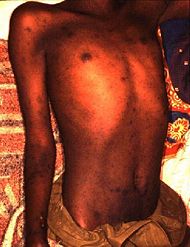Typhus
Typhus is any of several similar diseases caused by Rickettsiae[1] The name comes from the Greek typhos, meaning smoky or hazy, describing the state of mind of those affected with typhus. The causative organism Rickettsia is an obligate parasite and cannot survive for long outside living cells.
Multiple diseases include the word "typhus" in their description. Types include:
| Condition |
Bacterium |
Arthropod |
Notes |
| Epidemic typhus |
Rickettsia prowazekii |
lice on humans |
When the term "typhus" is used without qualification, this is usually the condition meant. Also, historical references to "typhus" are now generally considered to be this condition. |
| Murine typhus or "endemic typhus" |
Rickettsia typhi |
fleas on rats |
- |
| Scrub typhus |
Orientia tsutsugamushi |
harvest mites on humans or rodents |
Unlike the two conditions above, though it has the word "typhus" in the name, it is currently usually not classified in the typhus group, but in the closely related spotted fever group.[2] |
References
- ↑ Typhus at Dorland's Medical Dictionary
- ↑ Cotran, Ramzi S.; Kumar, Vinay; Fausto, Nelson; Nelso Fausto; Robbins, Stanley L.; Abbas, Abul K. (2005). Robbins and Cotran pathologic basis of disease. St. Louis, Mo: Elsevier Saunders. pp. 396. ISBN 0-7216-0187-1.
|
Infectious diseases · Bacterial diseases: G- (primarily A00-A79, 001-041,080-109) |
|
| Spirochaete |
|
|
|
|
|
Borrelia
|
Borrelia recurrentis (Relapsing fever) · Borrelia burgdorferi ( Lyme disease, Erythema chronicum migrans, Neuroborreliosis)
|
|
|
Spirillum
|
Spirillum minus (Rat-bite fever/Sodoku)
|
|
|
Leptospira
|
|
|
|
Multiple
|
Noma · Trench mouth
|
|
|
| Proteobacteria |
|
α
|
|
Rickettsiales
|
|
Rickettsiaceae/
(Rickettsioses)
|
|
Typhus
|
Rickettsia typhi (Murine typhus) · Rickettsia prowazekii (Epidemic typhus)
|
|
|
Spotted fever
|
|
Tick-borne disease
|
Rickettsia rickettsii (Rocky Mountain spotted fever) · Rickettsia conorii (Boutonneuse fever)
|
|
|
Other
|
Rickettsia akari (Rickettsialpox) · Orientia tsutsugamushi (Scrub typhus)
|
|
|
|
|
Anaplasmataceae
|
Ehrlichia/Anaplasma: Ehrlichiosis (Human granulocytic ehrlichiosis, Human monocytic ehrlichiosis)
|
|
|
|
Rhizobiales
|
|
Brucellaceae
|
|
|
|
Bartonellaceae
|
Bartonellosis: Bartonella henselae (Cat scratch fever) · Bartonella quintana (Trench fever) · either henselae or quintana (Bacillary angiomatosis)
|
|
|
|
|
β
|
|
Neisseriales
|
|
|
|
Burkholderiales
|
Burkholderia (Glanders, Melioidosis) · Bordetella ( Pertussis)
|
|
|
|
γ
|
|
Enterobacteriales
(OX-)
|
|
Lac+
|
|
|
|
Slow/weak
|
Serratia marcescens (Serratia infection) · Citrobacter
|
|
|
Lac-
|
Yersinia pestis ( Plague/Bubonic plague) · Yersinia enterocolitica
Salmonella enterica ( Typhoid fever, Paratyphoid fever, Salmonellosis) · Shigella (Shigellosis) · Proteus
|
|
|
|
Pasteurellales
|
Haemophilus: influenzae (Brazilian purpuric fever) · ducreyi (Chancroid)
Pasteurella multocida (Pasteurellosis) · Actinobacillus (Actinobacillosis)
|
|
|
Legionellales
|
|
|
|
Other
|
Thiotrichales/Francisella (Tularemia) · Vibrionales/Vibrio ( Cholera) · Pseudomonadales/Pseudomonas (Pseudomonas infection)
|
|
|
|
ε
|
|
|
|
| Chlamydiae |
|
|
| Bacteroidetes |
Bacteroides fragilis
|
|
Primarily rods except Neisseriaceae and Spirochaete. Primarily OX+ except Enterobacteriaceae. Primarily extracellular except Rickettsiales/Chlamydia/Treponema (obligate) and Brucella/Listeria/Legionella (facultative). Primarily aerobic or facultative anaerobic except Bacteroides.
|
|
